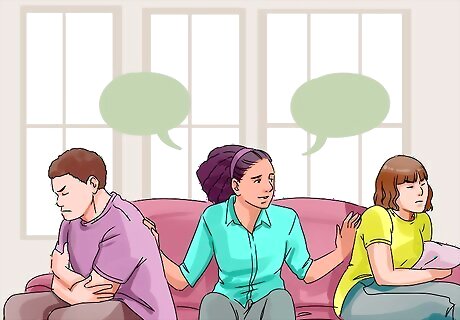
views
X
Research source
- Make sure that you’re actually dealing with conflict (and not a simple disagreement) by looking for disproportionate reactions and boundary violations.
- Keep your calm, ask plenty of clarifying questions, and give people the space to express themselves.
- Look for common ground and identify ways to compromise, which is key when it comes to resolving conflict peacefully and amicably.
- If you’re mediating conflict, try to be as equitable and fair with everyone involved as you possibly can.
Figuring Out The Dimensions of the Conflict

Look for disproportionate responses. A disagreement may not equate to a conflict. However, if someone acts way more upset or angry than the situation calls for, look closer at their behavior. This may indicate that they either have an internal conflict or source of stress. On the other hand, if their anger is directed at another, the two might have a conflict that needs resolving. Either way, you should exercise caution with this conflict so that it doesn't get out of hand or even violent. For example, getting very angry that your friend broke a disposable plastic cup is a disproportionate response. Think about your relationship with them to figure out if a behavior or past action has upset you deeply.

Think about tension that exists outside disputes. If you have a conflict with someone, you will always harbor ill will toward them, whether or not you are currently disputing something. If you find yourself upset upon their entering the room, you may need to resolve a conflict. It is natural to try to hide your conflict with them to avoid uncomfortable exchanges. A simple rivalry may be hard to address, but you should feel comfortable approaching them for reconciliation.

Think about how others color your perceptions. It is human nature to view comments and actions relative to the person who said or did them. However, if you find yourself consistently diminishing the ideas or work of others without much thought, you may have a conflict with them. Before addressing the conflict, try to compartmentalize your relationship with them so you can view their comments and contributions impartially. If you see that a coworker, for example, writes a report that another coworker sends back for edits, look closer. If they didn’t sit down and carefully read the report, you might help them address their conflict. Their relationship is coloring their perception of each other’s work.
Resolving Your Conflict With Another

Remain calm. Tempers will stand in the way of working through your differences. After all, the goal is making peace with one another, not getting revenge. Respectfully communicate to them, through a mediator if necessary, that you should both take some time to calm down. Then agree on a time and a place to discuss and resolve your conflict. Try to stay calm by remembering that settling the conflict is the goal here, not proving your point. Another tactic is asking them to help you come up with ways to solve the problem. This takes some of the pressure off you, which may help you relax. Trying to settle a conflict with tempers flaring is counterproductive. If either party is upset, call a quick break so you can discuss the issue calmly.

Make a list of your concerns. Before you meet with the other person, sit down and write out exactly what you think led to the conflict. Try to take personal history and personality out of the equation as much as possible. Think about the root of the problem and what specifically you need to change.

Allow the other person to talk. You will still be able to make all of your points, but make sure to let the other person state his or her concerns as well. Let them talk, even if you disagree, because interrupting will only add to the conflict. It is most important for each of you to figure out the conflict you disagree on than the ‘correct’ solution. Working toward accepting each other’s differing views is at the center of this process.

Ask questions. If you don't understand the other person's points, then ask him or her a follow-up question. Make a point to wait until there's a pause in the conversation, so it doesn’t seem like you’re interrupting. Don’t ask sarcastic or hostile questions, as this may turn your discussion into an argument. If you find their answers or reasoning ridiculous, remember that they are entitled to their opinion as you are yours. For example, a good follow-up question might be: “when did you first notice I wasn’t returning your phone calls?” This question simply seeks to establish a timeline for your conflict. An example of a combative follow-up question is: “did you try one of the million other ways to get in touch with me?” This question is intended to make the other person feel stupid and wrong. This will only make them more defensive and offended, taking you farther from a resolution to your conflict.

Be creative. Try to think of as many different solutions to the problem as you can. Both of you should try to think through the conflict before you meet, and then again when you get together and begin your discussion. Allow your discussion to flow in as many different directions as you can, as long as emotions don't get too heated, in order to resolve the conflict effectively. You may have to forgo getting your way. For example, the root of your conflict might be that your friend borrowed your car without asking, and nearly wrecked. They may not understand why you are so upset about it, and this lack of understanding has grown into anger. A solution might be that you don’t mind if they borrow your car, as long as they ask first and drive safely.

Take breaks. If you feel like one of you, or both of you, are getting too emotional, feel free to take as many breaks as you both need to. Take as much time as you need as soon as voices are raised, before anything too hurtful is said. You may also need time to think over their proposed solution or course of action.

Stay away from negative talk. Focus on the positive things instead of saying things like, "can't," "don't" or "no." The negative words will only make the conflict harder to resolve. They dwell on the conflict rather than the solution. At the end of the day, what you need the other person to accept is how you want to move forward. For example, don’t tell the other person: “I don’t like the way you borrow my car without asking.” While this may be an important aspect of your conflict, in the solutions phase of the conflict resolution, it keeps you dwelling on the past. Instead, tell them: “we need to establish some rules for using my car if you need to borrow it again in the future.” This sentence proposes a reasonable solution rather than simply restating what the issue is.

Find something you can agree on. There might be a conflict that is just not possible to resolve in one discussion. Think of something to do with the conflict that you both can agree on, and agree to come back to the topic later. It may take more than one discussion to resolve the conflict effectively. For example, you may not agree about whether it is unreasonable for someone to borrow their roommate’s car without asking. However, start by agreeing that the traffic incident they had on your car was inconvenient for all parties.

Look for compromise. In many conflicts, no one person is completely wrong, so try to find a compromise that you can both be happy with. Always try to be the ‘bigger person’ by finding a resolution that satisfies both of you. Don’t let this turn into a competition to see who can be ‘more reasonable,’ however. An example of a compromise might be giving one roommate laundry room privileges on weekend nights and weekdays, and the other on weekend days and week nights. By alternating who has time allotted to use the laundry machine, you avoid future conflicts surrounding both of you wanting to do the wash at the same time. Reader Poll: We asked 535 wikiHow readers how they would handle conflicts in their relationships, and 56% said they would work through it until they found a resolution. [Take Poll]
Mediating a Conflict Between Others

Think about whether you are the ideal mediator. You might see yourself as a talented counselor or friendly shoulder to cry on. However, you may not be the best mediator for every conflict resolution. Make sure you have a close, but impartial relationship with both parties. Family members make the best mediators for sibling disputes. Parents, older siblings, or neighborhood friends are good people to turn to for conflict resolution. Workplace disputes are a little more sensitive because there are laws and policies in place to control conflicts. Supervisors or human resource personnel are usually the appropriate parties to resolve conflicts. Check with your company handbook before acting as a formal or informal mediator.

Get them together. Tell the two parties you want to help them work through their differences. Find a time they can both get together to discuss their conflict. They won’t be able to openly discuss their feelings until they are in a room together with that intention. They may find a time themselves, or you may have to make suggestions. This will be easy if it is, for example, a workplace dispute. A supervisor can tell them that their work is suffering and they are required to discuss their conflict. Getting two fighting friends in the same room to settle a conflict may be more tricky. The most straightforward way is to tell each of them you want to help them talk through their problems with each other. If it is too sensitive an issue, you might need to invite them to the same get together without saying anything about the other person. This is a risky move, however. EXPERT TIP Gene Linetsky, MS Gene Linetsky, MS Startup Founder & Engineering Director Gene Linetsky is a startup founder and software engineer in the San Francisco Bay Area. He has worked in the computer science industry for over 30 years, with experience spanning staffing and management of engineering teams, game design and development, communication protocols, sales automation, and more. He has also been involved in incorporating computer science curriculum into high schools, developing educational software, and was a co-author on a computer science textbook. He is currently the Director of Engineering at Poynt, a technology company building smart Point-of-Sale terminals for businesses. Gene Linetsky, MS Gene Linetsky, MS Startup Founder & Engineering Director Try to find the positive. Gene Linetsky, a startup founder and software engineer, says conflict can sometimes be a good thing. He says: "It's often effective to get two people with comparable skills working together on the same task because they will check each other's work. So out of this contention, which hopefully most of the times is friendly, you'll get a much better solution than if you had just asked one person to work on the project."

Take the lead. You don’t need to control the entire conversation, as this may hinder organic conflict resolution. However, you might consider saying a few opening words to get them started. After all, they should know that their conflict is obvious to an impartial observer, and therefore potentially harmful. This implicit fact may bring home the reality of their conflict. For example, you may need to explain more to children. Try telling each of them why their conflict is unhealthy and harmful. Remind them how much fun they used to have. If you are handling a conflict between two close adult friends, you can be more brief and informal. Tell them their conflict is upsetting and uncomfortable for those around them. They need to start talking. For workplace disputes, you may have a script or list of talking points you are legally required to cover. If not, a good route is to tell them that their conflict is affecting their work performance. Check with your company policies to see what is expected of you.

Give both parties a chance to speak. The most important part of this process is allowing both parties a chance to air their grievances. Try not to interrupt them, unless they are getting overly angry or hostile. It is natural for them to show some emotion, since they are releasing pent-up tension.

Listen to both sides. Keep an open mind. Even if you have an idea of who is in the right, alienating one person by giving them less time to speak won’t solve the problem. You won’t be able to come up with compromise solutions without listening to both sides’ grievances.

Allow for discussion. After you state the purpose of the discussion, you are there as an impartial bystander. Feel free to step in if conversation gets heated or no one is talking. However, remember that this is an opportunity for them to talk, not you.

Take a side, if appropriate. One side may clearly be in the wrong. It can alienate one of the parties if you refuse to acknowledge that they were clearly in the right. This doesn’t mean both parties aren’t both at fault for perpetuating the conflict. However, certain situations call for the open recognition that one side was more in the wrong at the root of the conflict. For example, you may choose to point out that your friend was in the wrong for borrowing his friend’s car without asking.

Offer a few compromises. After having heard both sides of the conflict and having allowed them to speak for themselves, offer options. Giving them options makes them proactive in picking the best settlement. Offer the solutions as logical answers, not based on your opinion. For example, you might offer your friends with the car dispute the following solutions. You can quit loaning him your car altogether to avoid future problems. You can continue to loan him your car, but make ground rules clear. But recognize you may not be able to solve their problem. You don’t need to come up with a solution if there is no easy answer to their problem. For example, if one person’s partner left them for second person, you may not have an easy solution. However, getting their feelings out in the open may be therapeutic for both of them.

Encourage them to make up. You should try to get them to conclude their conflict resolution on a positive note. Encourage them to tell each other that they are no longer going to hold a grudge. Pay attention to their emotions, however. Don’t force them to shake hands or ‘kiss and make up’ when they are not ready to. This may take them from being on the path to acceptance back to anger. Try to avoid telling them to say they’re sorry. Simply asking them to make up should provoke them to say they’re sorry naturally. Saying the words ‘I’m sorry’ is a point of contention for many people, and they will do that when they’re ready.


















Comments
0 comment